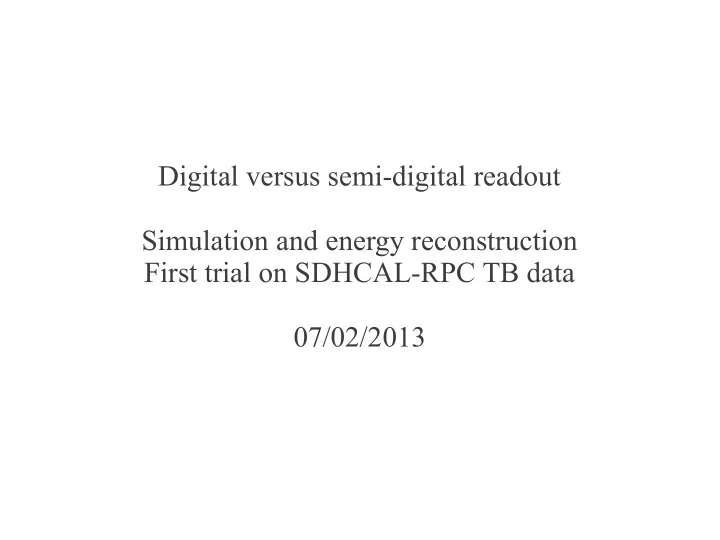

Digital versus semi-digital readout Simulation and energy reconstruction First trial on SDHCAL-RPC TB data 07/02/2013
Simulation ● Geometry – 100 Micromegas layers of 1x1 m2 – SDHCAL absorbers ● Data set – 10000 pion events from 10 to 70 GeV, every 10 GeV ● Digitisation – Low threshold at 15 eV (gas ionisation potential) – Medium threshold at 5 MIP (set in keV from muon Landau distribution) – High threshold at 15 MIP (set in keV from muon Landau distribution)
Nhit distributions – 3 thresholds Low thr. Medium thr. High thr. ~ 0 MIP 5 MIP 15 MIP
Distribution moments Get RMS and MEAN from smoothed distribution instead of fit parameters → MEAN not over-estimated → RMS not under-estimated 1. Fit Novosibirsk function to histo1 2. Fill histo2 from fit function (10 5 entries for a smooth histo) 3. Get MEAN and RMS of histo2
Response to pions in Nhit Very similar to Micromegas TB data Fit function: N0 = [0]/[1] * log(1 + [1] * E) Work only for the low threshold: medium thr. ~ linear while high thr. rises faster than linear
Energy reconstruction - pure digital Inverse fit function: E = exp([1] / [0] * N0 – 1) / [1]
Performance for pure digital Linearity almost perfect (no surprise, we used the inverse of the response) However, corrections degrade the energy resolution above at 30 GeV
Degradation of the resolution The EM fraction of hadron showers increases with energy. With a digital readout → saturation of Nhit → worse resolution. 30 GeV 10 GeV
Degradation of the resolution The EM fraction of hadron showers increases with energy. With a digital readout → saturation of Nhit → worse resolution. 70 GeV 50 GeV
Energy reconstruction - semi-digital Maximum likelihood method Calculate at each energy, the probability to observe (N0,N1,N2) The best estimate of the energy is then the one for which the probability is maximum Hypothesis N0, N1, N2 are not correlated (verified in 2D plots and with correlation coef. centred at 0) → p(N0,N1,N2) = p(N0) * p(N1) * p(N2) Calculation of probability Parametrise the energy dependence of Novosibirsk fit parameters (mu,sig,tail,norm) Normalised distributions → p(Ni,E) at any energy in the parametrisation range
Energy parametrisation - thr0 Calculation of probability Parametrise the energy dependence of Novosibirsk fit parameters (mu,sig,tail,norm) Normalised distributions → p(Ni,E) at any energy in the parametrisation range Tail Norm Sigma Mean
Thr0 Tail Norm Sigma Mean Thr1 Thr2
Energy parametrisation - thr0 Calculation of probability Parametrise the energy dependence of Novosibirsk fit parameters (mu,sig,tail,norm) Normalised distributions → p(Ni,E) at any energy in the parametrisation range product
Energy reconstruction - semi digital Pure digital Semi digital Distributions are more symmetrical!
Performance semi-digital Linearity slightly worse than with pure digital (for which it had to be ~ perfect) No degradation of resolution: OFFLINE COMPENSATION works!
Comparison pure/semi digital Semi-digital non linearity below 4% at 10 GeV, below 2% in 20-70 GeV Energy resolution: improvement already at 20 GeV
Next steps Apply semi-digital energy reconstruction method to RPC testbeam data (hoping the detector is proportional...) Add more discrimination power to likelihood method → barycentre of hits along beam axis is correlated to the beam energy → also: radial position of hits?
SDHAL/RPC testbeam data August-Sept. Period: H6, better beam conditions claimed by RPC group Difference with simulation: 100 perfect layers → 47 layers → leakage (in addition to geom. saturation) Environmental variations → systematics Proportional signals → saturated signals (?) Pure samples → electrons, pions, cosmics, muons → PID Before parametrisation of Novo. function with energy for 3 thresholds → many checks!
SDHAL/RPC testbeam data August-Sept. Period: H6, better beam conditions claimed by RPC group Difference with simulation: 100 perfect layers → 47 layers → leakage (in addition to geom. saturation) Environmental variations → systematics Proportional signals → saturated signals (?) Pure samples → electrons, pions, cosmics, muons → PID Before parametrisation of Novo. function with energy for 3 thresholds → many checks!
Leakage 50 GeV 30 GeV 70 GeV
Leakage → Select shower starting in 12 first layers (cut on Nhit in last layers not allowed, would bias the sample)
Sample purity 10 GeV 15 GeV MC DATA e/h 1/1 electrons pions electrons pions SDHCAL is ~ compensated at low energy → PID e/h based on Nhit useless. → Use transverse and longitudinal information → Centre of gravity radial and along Z (proved to work in simulation too)
Systematics Thr2 Thr0 Thr1 Mean Thr2 Thr0 Thr1 Sigma At a given energy, the Novosibirsk parameters show some spread for 3 thr. The trends with energies are to be understood...
Conclusion It seems that we have a method that improves the energy resolution by using the semi-digital information. Lot of work still to understand the RPC data... … hoping it is possible.
Recommend
More recommend